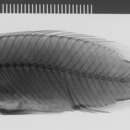en
names in breadcrumbs


Parananochromis caudifasciatus és una espècie de peix de la família dels cíclids i de l'ordre dels perciformes.
Els mascles poden assolir els 10,5 cm de longitud total.[3]
Es troba a Àfrica: sud del Camerun, nord del Gabon i Río Muni (Guinea Equatorial).[3]
Parananochromis caudifasciatus és una espècie de peix de la família dels cíclids i de l'ordre dels perciformes.
Parananochromis caudifasciatus (Syn.: Nanochromis caudifasciatus, Pelmatochromis caudifasciatus) ist eine Fischart aus der Familie der Buntbarsche (Cichlidae), die im südlichen Kamerun und im festländischen Teil von Äquatorialguinea im Einzugsgebiet der Flüsse Dja, Nyong, Lokundje und Ntem vorkommt.
Parananochromis caudifasciatus erreicht eine Standardlänge von maximal 10 cm und hat einen mäßig langgestreckten Körper dessen Höhe 29,7 und 36,2 % der Standardlänge beträgt. Die Kopflänge liegt bei 29,7 bis 37,5 % der Standardlänge. Die Schnauze, bei Fischen der Bereich zwischen dem vorderen Augenrand und der Spitze des Mauls, ist kurz und abgerundet. Das Maul ist klein, der Unterkiefer steht leicht aufwärts. Rücken- und Bauchprofil sind leicht gebogen. Der Schwanzstiel ist für gewöhnlich höher als lang. Die Schwanzflosse ist abgerundet.
Die vordere, obere Seitenlinie liegt hoch, nur durch eine oder zwei Schuppenreihen von der Rückenflossenbasis getrennt.
Parananochromis caudifasciatus ist grau bis hellbraun gefärbt, der Bauch ist heller. Wange und Kiemendeckel sind hellgelb. Tränenstreifen sind normalerweise vorhanden. Ein dunkles Längsband verläuft vom Kiemendeckel entlang der Mitte der Körperseite bis auf den Schwanzstiel. Dort kann es sich zu einem dunklen Fleck verbreitern. Das Längsband kann auch in eine Reihe von 8 bis 9 Flecken aufgelöst sein. Von diesen Flecken verlaufen senkrechte Streifen bis zur Basis der Rückenflosse. Die Sichtbarkeit und Form der dunklen Zeichnungselemente ist stimmungsabhängig. Die Rückenflosse hat einen schwarzen Rand, darunter liegt eine weiße Linie. Das gleiche Muster zeigt die obere Hälfte der Schwanzflosse. Die Schwanzflosse zeigt für gewöhnlich ein dichtes Muster von senkrecht angeordneten Punkten, die oft auch miteinander zu senkrechten Bändern verschmolzen sind. Die Bauchflossen sind hellblau, ihr Vorderrand ist weiß. Die Afterflosse der Männchen ist dunkelviolett, die der Weibchen ist hellviolett. Der weichstrahlige Abschnitt der Rückenflosse und der hintere Abschnitt der Afterflosse sind bei beiden Geschlechtern grau mit einigen Reihen heller, bläulicher Punkte, die bei den Männchen deutlicher sichtbar sind als bei den Weibchen. Brust und Bauch geschlechtsreifer Weibchen sind rosig-violett.[1][2]
Parananochromis caudifasciatus lebt nur in Gewässern, die in bewaldeten Gegenden liegen. Die Art bildet zur Fortpflanzung monogame Paare und ist ein Substratlaicher, der in Höhlen laicht.[3]
Parananochromis caudifasciatus (Syn.: Nanochromis caudifasciatus, Pelmatochromis caudifasciatus) ist eine Fischart aus der Familie der Buntbarsche (Cichlidae), die im südlichen Kamerun und im festländischen Teil von Äquatorialguinea im Einzugsgebiet der Flüsse Dja, Nyong, Lokundje und Ntem vorkommt.
Parananochromis caudifasciatus es una especie de peces de la familia Cichlidae en el orden de los Perciformes.
Los machos pueden llegar alcanzar los 10,5 cm de longitud total.[1]
Se encuentran en África: sur del Camerún, norte del Gabón y Río Muni (Guinea Ecuatorial ).
Parananochromis caudifasciatus es una especie de peces de la familia Cichlidae en el orden de los Perciformes.
Parananochromis caudifasciatus Parananochromis generoko animalia da. Arrainen barruko Actinopterygii klasean sailkatzen da, Cichlidae familian.
Parananochromis caudifasciatus Parananochromis generoko animalia da. Arrainen barruko Actinopterygii klasean sailkatzen da, Cichlidae familian.
Parananochromis caudifasciatus is een straalvinnige vissensoort uit de familie van de cichliden (Cichlidae).[1] De wetenschappelijke naam van de soort is voor het eerst geldig gepubliceerd in 1913 door Boulenger.
Bronnen, noten en/of referenties